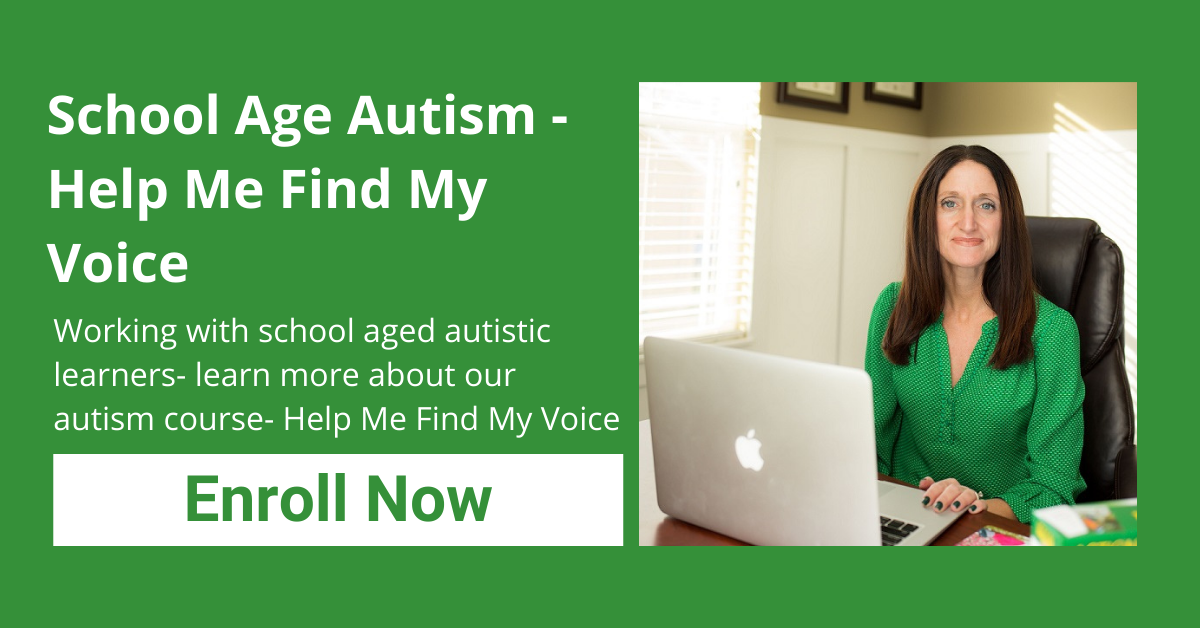[fusebox_track_player url="https://chrt.fm/track/5GD6EB/www.buzzsprout.com/1572088/14735681-172-they-have-a-voice-are-we-listening-with-joe-veneziano-and-dr-shannon-shea.mp3?download=true" title="Episode #172: They Have a Voice, Are We Listening? with Joe Veneziano...
Episode #087: Speech Sound Production and Autistic Learners – A Talk With Tamara Kasper
https://vimeo.com/742140131
W
hat is it that develops speech production in our learners? Today, Tamara Kasper, BCBA and SLP, is sharing some really great and specific information on how speech production and reinforcement differs between typical developing children versus children with autism.
Speech Sound Production
In typically developing children, speech sounds are reinforced differentially and automatically when making sounds that sound like words. For example, they get a cookie when they make a sound that sounds like cookie or they get happy, hugging excitement when they say something that sounds like mama or dada. Naturally, typical children are encouraged by the sounds and interactions in their environment and want to match the sounds made by the people they value in their world. This is where self-correction and refinement comes in because they will notice and hear how their sounds may sound different from the adults around them.
In non-typically developing children, specifically those with autism, they are more sensitive to social stimuli and are less likely to be affected by the attention of their parents or guardians in regards to their sounds. So the traditional, automatic reinforcement to make and refine sounds is not occurring. Additionally, these learners will not likely notice how their sounds sound different from those around them, leading to no self-correction as sound production continues.
Therapy for Speech Sound Production
Tamra shares her assessment and criteria for determining readiness for working on speech production. She collects metrics from the VB-MAPP, indicating responses, manding rate and variety, instruction cooperation development, and echoic repertoire. The scores and data from these metrics will relay whether a Natural Environment or Structure Teaching therapy is appropriate for these students. Within these systems, Tamra discusses the programs she uses. She shares today a little bit of her rubric on how she assigns these programs based on the needs of the child and assessment criteria.
If you’d like to learn more about Tamra, you can find out more about her work and some video tips at Northern Speech Services. Additionally, if you’d like access to her therapy rubric discussed today and other resources, you can reach her via email.
#autism #speechtherapy
Today’s Guest:
Tamara S. Kasper, MS, CCC-SLP, BCBA, is a pediatric Speech-Language Pathologist who has treated children with challenging behavior since 1990, specializing in children with autism since 1995. Tamara’s commitment to the children she serves led her to pursue treatment methods outside the field of Speech-Language Pathology. Under the mentorship of renowned Behavior Analyst Dr. Vincent Carbone and his protégé, she became a Board Certified Behavior Analyst in 2006. She partnered with Nancy Kaufman, an expert in treatment of apraxia of speech, to create The K&K Sign to Talk Materials and Strategies. She is a contributing author to the book, “Understanding Ethic in Applied Behavior Analysis: Practical Applications.” Described by attendees as “inspirational” and “empowering,” Tamara is a frequently invited international lecturer, enthusiastically sharing intervention techniques that promote early non-vocal communication skills, build functional verbal and vocal behavior, improve speech production skills, promote social communication skills and combine social skills training with physical training. She has lectured and treated individuals across the United States and Canada as well as in Ethiopia, Senegal, Greece, Germany, England, Ireland, and other countries. She is a past recipient of WISHA’s Clinical Achievement Award. Tamara directed The Center for Autism Treatment near Milwaukee, Wisconsin for 15 years, and now serves as Director, Clinical Center of Excellence for Caravel Autism Health.
What’s Inside:
- Acquisition of speech production in typical vs non-typical children.
- Do typically developing children shape sounds to match those in their environment?
- How do we know when an autistic learner is ready for speech sound production in therapy?
- Assessment and Criteria for determining therapy training for sound production.
- Training programs for natural environment and structured teaching therapy.
Mentioned In This Episode
—tkasper@centerautismtreatment.org
—Kasper Enterprises
—Northern Speech Services
—ABA Speech: Home
—Start Communicating Today – Waitlist – ABA Speech
—Help Me Find My Voice – EVERGREEN – ABA Speech
—September 13th FREE Webinar 8-9 pm EST registration link
—September 14th Free Webinar 8-9 pm EST registration link
Rate, Review & Subscribe
If you found this podcast helpful, please consider rating and reviewing my show! This helps me to support support more people — just like you!
If you have not done so already, subscribe to the podcast. This ensures that you do not miss an episode!
Listen on
Apple Podcasts
Listen on
Stitcher
Subscribe
via Email
You Might Also Like…
Episode #171: SLP Services in an ABA Setting- A Conversation with Susan Browning
[fusebox_track_player url="https://chrt.fm/track/5GD6EB/www.buzzsprout.com/1572088/14694844-171-slp-services-in-an-aba-setting-a-conversation-with-susan-browning.mp3?download=true" title="Episode #171: SLP Services in an ABA Setting- A conversation with Susan...
Episode #170: A Conversation with Maura Weis – A Family’s Autism Journey
Maura Weis is...

